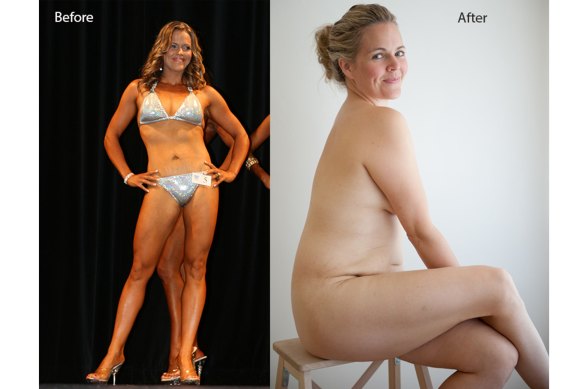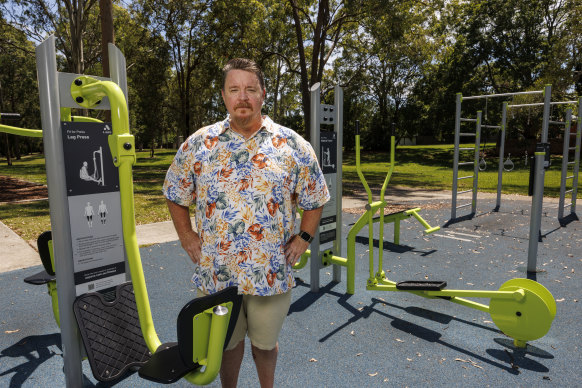‘I watch my diet like a toddler near a pool’: Body mass, bias and the big shift in the weight debate

Kelly Cooper still hears echoes of voices that shamed her for most of her life.
“I was running this morning, training for heart rate to increase endurance, going up a hill, and I thought, ‘God, I can go faster than this … I don’t want some dude rolling down his window and saying, come on fatty, get up that hill’.”
Kelly Cooper lived with obesity until six years ago.Credit:Simon Schluter
Having heard horrible comments about her weight since early childhood, and experienced “borderline stage 3 obesity”, Cooper knows her physiology, and other people’s attitudes, are with her for life.
The labels are “part of my fabric”, she says. “It is not something that goes away after having decades of people commenting on your weight.”
The dietitian, health advocate and mother of two got on top of obesity about six years ago using a series of 12-week challenges she describes as probably not that healthy, plus serious weights training.
In a video for the Weight Issues Network, Cooper says, “my battles are far from over yet: I watch my diet like a toddler near a pool, I can’t take my eye off it for a second”.
“I watch my diet like a toddler near a pool, I can’t take my eye off it for a second.”
Cooper tells a common story: strangers, employers and even some health professionals judge and stigmatise overweight and obese people, assuming size reflects their choices.
A chunk of the population is affected. According to the Australian Institute of Health and Welfare, 14 million, or two in three Australian adults, are overweight or obese.
Given recent science showing obesity is a disease, experts want to reduce the stigma potentially preventing many of those with excess weight from accessing the healthcare they need.
Signs of change emerged this week with body-positive activist Taryn Brumfitt being recognised as the Australian of the Year, and widespread public support for tennis commentator Jelena Dokic, who outed and disarmed her army of social media body trolls.
A comment targeting Jelena Dokic on social media.Credit:Instagram
The success of revolutionary weight-loss drugs is giving further credence to science showing physiological links with obesity.
Photos of Brumfitt went viral in 2013 after she posted on Facebook about accepting her post-baby silhouette, having previously sculpted it with intensive body-building. At the awards, she highlighted the psychological impact of body judgment: “We weren’t born into the world hating our bodies,” she said.
“This is something the world has taught us. Body-shaming is a universal problem and we have been bullied and shamed into thinking our bodies are the problem.”
Attacking people for their shape does the reverse of helping them improve their health, says Tiffany Petre, director of The Obesity Collective. What helps is attitudinal change through awareness of research, and acceptance of evidence that shows people do not choose obesity.
Taryn Brumfitt’s social media post about accepting her post-baby silhouette went viral in 2013.
Petre describes fat shaming as “the last acceptable stigma”.
“A lot of people might assume if someone’s living in a larger body, they haven’t tried, when in reality they might have tried harder and focused on it more than everyone else in the room,” she says. “It is because of biology and other drivers, but assumptions are made about character.”
“You have to get people interested in the new science, and the lived experience stories. When you shower them with interesting new facts that haven’t been part of the narrative [around weight] and show them personal stories, it does chip away at why they hold on to their views so strongly.”
People want to be obese “about as much as they want to have asthma”, she says.
Tennis commentator Jelena Dokic received widespread support after calling out vicious shaming of her body on social media.Credit:Nine
Catherine Bacus, a GP and former chair of the Royal Australian College of General Practitioners’ specific interest group on obesity management, says patients tell her the stigma runs so deep that they are overlooked in job applications or promotions even if they are better qualified. For many, “internalised stigma” is also severe.
“But you can’t argue with science, and when we can clearly see weight is regulated by your brain and not willpower … and there’s good evidence to show the body responds to weight loss in the direction of regain, we need to get about helping people with hunger drive and appetite drive,” she says.
“There are really good treatments for this such as semaglutide [branded as Ozempic and the higher-dose Wegovy] showing it is a condition that can be managed, like asthma.
“Depression was stigmatised before there were effective treatments for it … I’m hoping with better treatments and understanding of what truly causes obesity or weight gain, we can also get about managing it in a kinder way.”
Some people given semaglutide have been demeaned when they go to collect their script, several obesity experts have said, due to a global shortage of a drug also used to treat type 2 diabetes.
Jason Maloney, a nurse-practitioner and former footballer who uses his obesity experience to support patients, says this is unfair and unjustified, as obesity is a leading cause of type 2 diabetes and semaglutide users are trying to prevent themselves developing it and other serious illnesses.
Maloney, a father of four and gym-goer, comes from a family in which “the men are all about 6′4″ and weigh somewhere between 120 and 140 kilograms”.
He says the old advice that eating less and moving move will cure obesity is not true for those whose bodies are genetically prone to store and defend high weight, and that the new drugs are transformative.
Jason Maloney achieved dramatic weight loss using one of a new range of drugs, but has regained weight since global supply of the drug ran out.Credit:Glenn Hunt
“It de-stresses food. Before I was on Ozempic, I’d have my lunch and start thinking about what I was having for dinner, or start craving something. I was wanting to eat the shoes off a low-flying duck around 4pm, that was how I existed. I don’t think about it anymore,” he says.
It is distressing that supplies of semaglutide ran out last year due global demand, he says. Without it, weight gain relapses, as it has for Maloney.
Brian Oldfield, a Monash University physiology researcher and editor of the field’s leading journal, Obesity Reviews, says as awareness of how the drugs mimic hormones spreads, it will reframe the argument about obesity.
“Having obesity is prompted by genetics to a large extent and represents dysregulation of your normal physiology. The normal pattern of hormones, and their ebbs and flows in relation to meals, doesn’t happen,” he says.
“After we have a meal, we should have an escalation or heightening of those hormones that reduce hunger or create satiety, but they don’t work well if you’re obese. On the other side, the hormones that create hunger are exaggerated in people living with obesity.
“People living with obesity are really fighting this mountain of hormones that are not working as they should – and are, in fact, working against them.”
Sadly, Oldfield learns how judgemental many still are about those in larger bodies each time he goes on talkback radio.
He is asked things such as, “Is this really a way for people who are overweight to live the way they want and just take a pill?” Listeners respond in a similar vein.
“It couldn’t be less like that,” says Oldfield. “It [semaglutide] is prescribed with diet and exercise, and from my interaction with people challenged with those issues, they are not the sort of people who will just eat what they want.
“When you actually talk to people with obesity, most of them have made four to five life-changing attempts to lose weight. The concept of them just taking a pill and eating what they want is completely unreal.”
The Morning Edition newsletter is our guide to the day’s most important and interesting stories, analysis and insights. Sign up here.
Most Viewed in National
From our partners
Source: Read Full Article




